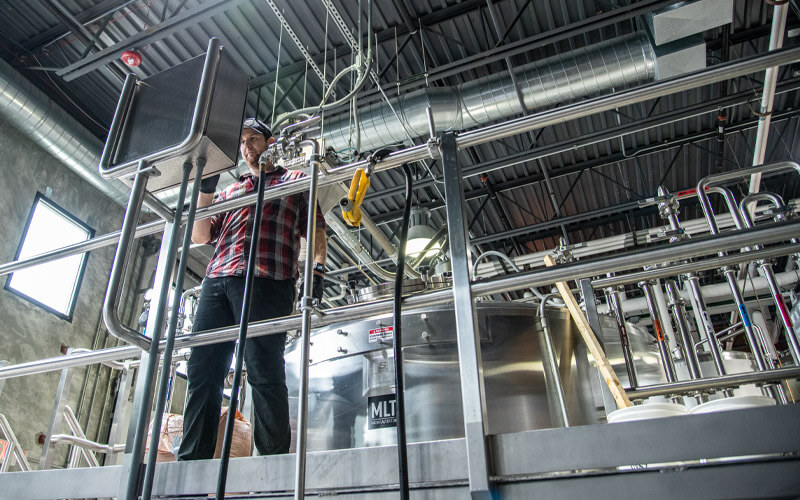Why hello there!
Kicking off this edition of The Brewer’s Corner, I want to start by giving a shout out to those who are out there doing there part to survive and make the world a better place. Every passing day there are new, unique challenges that affect us all. I wish I could list out all the heroes, but there are simply too many. There are a few brewhouse heroes of mine, however, that I would like to acknowledge – and you may know them. That would be the Alter brewing team of Alfred, James, Mark, and Matt Bentley (honorary). These guys are sacrificing their time, bodies, families and health to make sure that the draft lines stay filled and the cans keep leaving the warehouse. It has been a insanely challenging, but they are getting it done. Thanks, guys – can’t do it without you! Of course, the entire Alter team is dedicated to the process in one way or another so big effing props to them too.
Brewing on a good day can still be a formidable task. Beer is ambivalent to your daily life and what you have plans for. We can only do our best to keep it happy while it moves its way to your fridge or glass. This is how it goes for Alterior Motive:
Day 1 – Brewday #1
- From start to finish, it takes about 7 hours to complete a brew. We must also ensure we have a clean tank, proper water, healthy yeast, milled grain, and other supplies (generally all prepped the day before a brew).
Day 2 – Brewday #2
- Since our tanks are 40bbls and our brewhouse is 20bbls, we must brew twice in succession to fill a fermenter. Another 7 hours of brewing with everything going right. Once the fermenter is filled, we then let it ferment around 67F and then bump it up to 72F near the end to help clean up off-flavors and aromas.
Day 5 – Harvest and Dryhop
- For us, we reach terminal gravity (the beer is mostly done fermenting) in 4 to 5 days. Alterior Motive is an IPA, so it will need to be dryhopped. But first, we have to harvest the used yeast on the bottom. This way we can use it for the next batch. We shoot to use our house yeast 7-10 times before dumping and starting over with fresh yeast. After the yeast is harvested, we can then dryhop it. This means throwing 77 pounds of dank hops through the top manway and then sealing it back up before it explodes. Which is a whole other story.
Day 8/9 – Cold Crash
- When the beer has sat with hops for about 3 days, it’s time to “crash” it. This means checking to make sure there are no off flavors (a practice called VDK) then sending the temperature down from 72 to 50, then 50 to 32 on the next day. This helps with dryhop extraction and also eases the amount of time it takes to clarify the beer later down the line.
Day 13/14 – Cold Dump
- Once the beer is cold and has sat for a few days, we dump all the stuff that has fallen out of suspension (hops, unharvested yeast). We don’t want the beer to sit on these items too long otherwise it can start to leech out negative flavors and aromas into the final product.
Day 17 – Cold Dump #2 and Transfer to Bright Tank
- We do one final cold dump and then send the beer into the bright tank where it is then carbonated, filtered, and conditioned.
Day 20 – Packaging
- When you have clear beer that is carbonated to spec, we can then either keg it or can it. Canning can take anywhere from a half to a full day. Kegging is much easier and more reliable, but can still take most of the day to do depending on how you split it up.
This is super stripped down and doesn’t cover all the other prep-work involved in each step – but it gives you an idea of how it goes down. When everything goes right, it can be very rewarding! But brewing is generally one big roller coaster ride with ups and downs. We really enjoy the ups, and try to learn from the downs. Once the train leaves the station, you never know what can happen.
Some fun beers coming down the DG pipeline…
- Foeder Pils – IT’S COMING, but we have to wait for the right moment to fit it into the packaging mix. For now, it is super happy staying inside its wooden blanket.
- Orange Hwip – Version #2 is mostly the same but we amped up the orange and increased the vanilla presence. I think we nailed it.
- Kveik Storm – Norwegian yeast (kveik) ferments above 90F and puts out huge ripe-fruit and orchard aromas. Very excited to finally do one.
- King’s Blood – See Foeder Pils.
- Barrel-Aged Barley Wine – We will be taking the original barley wine brewed last year that has been sitting in the barrels and blending it with a fresh higher alcohol batch to round it out and provide more sweetness. Plan is to put it into bombers by November.
- Swedda Wedda – This silky oatmeal stout is just around the corner, I will be brewing it sometime in September.
- Foeder Helles – This will be brewed very soon so we can refill the foeder once the Pils has checked-out from its extended stay.
That about does it, everyone. Thanks for reading and stay safe out there! Don’t forget – register to vote!
-Matt





